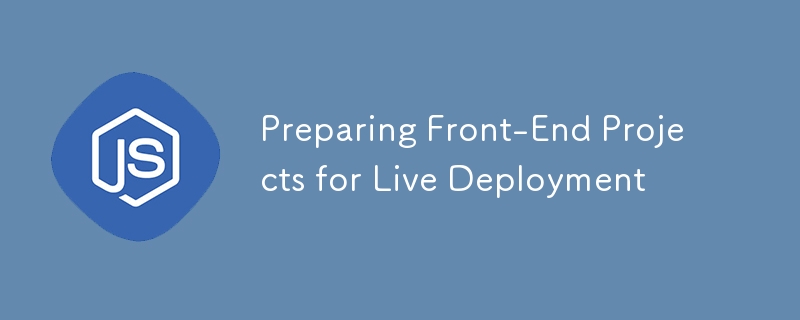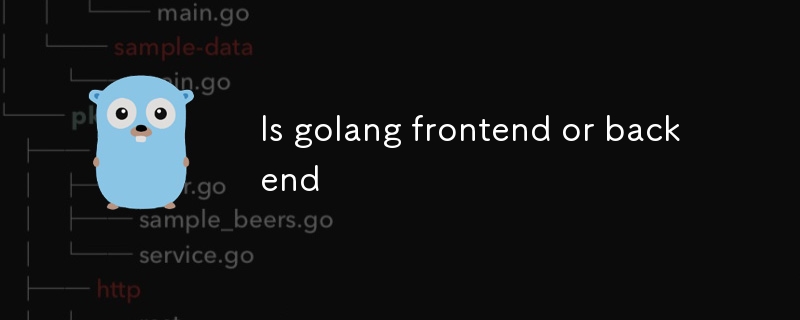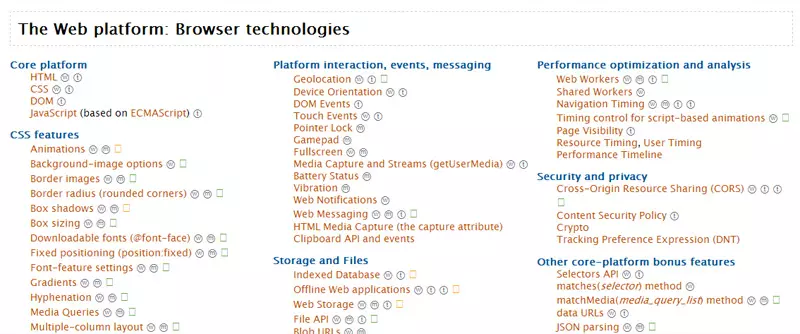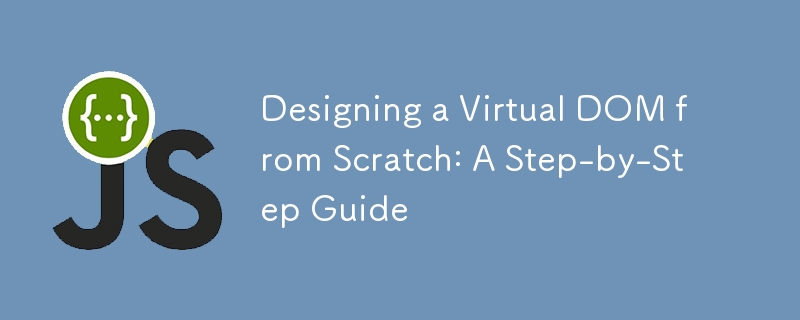Found a total of 10000 related content

Preparing Front-End Projects for Live Deployment
Article Introduction:Preparing Front-End Projects for Live Deployment
Deploying a front-end project is more than just uploading files to a server. It takes careful planning, optimization, and a good understanding of hosting environments to make sure your website or
2024-12-08
comment 0
980

Python vs. JavaScript: The Learning Curve and Ease of Use
Article Introduction:Python is more suitable for beginners, with a smooth learning curve and concise syntax; JavaScript is suitable for front-end development, with a steep learning curve and flexible syntax. 1. Python syntax is intuitive and suitable for data science and back-end development. 2. JavaScript is flexible and widely used in front-end and server-side programming.
2025-04-16
comment 0
1073

Is golang frontend or backend
Article Introduction:Golang is mainly used for back-end development, but it can also play an indirect role in the front-end field. Its design goals focus on high-performance, concurrent processing and system-level programming, and are suitable for building back-end applications such as API servers, microservices, distributed systems, database operations and CLI tools. Although Golang is not the mainstream language for web front-end, it can be compiled into JavaScript through GopherJS, run on WebAssembly through TinyGo, or generate HTML pages with a template engine to participate in front-end development. However, modern front-end development still needs to rely on JavaScript/TypeScript and its ecosystem. Therefore, Golang is more suitable for the technology stack selection with high-performance backend as the core.
2025-07-08
comment 0
542

Python vs. JavaScript: Use Cases and Applications Compared
Article Introduction:Python is more suitable for data science and automation, while JavaScript is more suitable for front-end and full-stack development. 1. Python performs well in data science and machine learning, using libraries such as NumPy and Pandas for data processing and modeling. 2. Python is concise and efficient in automation and scripting. 3. JavaScript is indispensable in front-end development and is used to build dynamic web pages and single-page applications. 4. JavaScript plays a role in back-end development through Node.js and supports full-stack development.
2025-04-21
comment 0
838

Fix - There Are Some Data After the End of the Payload Data - MiniTool
Article Introduction:When you use the 7-Zip application, you may receive the “There is some data after the end of payload data" warning message. This is not a general error but more like a warning message as it does not interrupt the extraction process. This post fr
2025-06-04
comment 0
236

What is frontend security
Article Introduction:The reason why front-end security is easily overlooked is that many people think that the front-end is just a "display page", and the real important logic and data are on the back-end. However, with the popularity of the front-end separation architecture, the front-end has undertaken more and more data processing and interaction tasks, becoming a potential target of attackers. 1. XSS attack steals cookies or hijacks sessions by injecting malicious scripts, prevents the need to escape user input, use CSP, and avoids the need to directly insert DOM; 2. CSRF attack induces user operations by forging requests, prevents the need to use SameSiteCookies, add CSRFTokens, and checks the Referer header; 3. The risk of third-party dependency comes from vulnerable npm packages or CDN resources, prevents the need to scan dependencies regularly and avoids
2025-07-03
comment 0
638

Drowning in Tools in the Web Development Industry
Article Introduction:Key Takeaways
The web development industry is saturated with an overwhelming number of tools, apps, scripts, plugins, libraries, and more. This can be both a boon and a bane for front-end developers, providing an endless supply of resources while
2025-02-22
comment 0
1212

How to use the HTML5 Data attributes for custom data.
Article Introduction:HTML5's data attribute is a standard way to store custom data on page elements. 1. It starts with data-, such as data-user-id. The data is invisible to the user but can be accessed through JavaScript; 2. Use the dataset attribute to read or set the data, and the hyphen is converted to camel; 3. Suitable for front-end template rendering, component state management, interactive control and other scenarios; 4. Precautions include avoiding storing sensitive or large amounts of data, preventing naming conflicts, paying attention to data type conversion, and reasonable use to avoid performance problems. Correct use of data attributes can make the front-end logic clearer and more concise.
2025-07-04
comment 0
287

How to Use Service Workers to Communicate Across Browser Tabs
Article Introduction:This article is excerpted from SitePoint's Daily Subscription Newsletter Versioning, which provides developers with selected links in front-end, back-end, design and user experience, news, business and other fields to help them maintain the latest knowledge and information. Learn more and sign up to subscribe, visit here.
Tim Evko is a front-end developer who manages a code base based primarily on React and is also the team leader of ExecThread, a company that focuses on providing job search information to professionals. In his spare time, he will exercise in the local gym and is committed to becoming a better competitive Crossfit athlete.
What are the technical concepts or trends you are most interested in at the moment?
I've been obsessed with Service recently
2025-02-16
comment 0
602

How to separate the front and back end of wordpress
Article Introduction:It is not recommended to directly modify the native code when separating WordPress front and back ends, and it is more suitable for "improved separation". Use the REST API to obtain data and build a user interface using the front-end framework. Identify which functions are called through the API, which are retained on the backend, and which can be cancelled. The Headless WordPress mode allows for a more thorough separation, but it is more cost-effective and difficult to develop. Pay attention to security and performance, optimize API response speed and cache, and optimize WordPress itself. Gradually migrate functions and use version control tools to manage code.
2025-04-20
comment 0
439

Understanding the differences between Laravel Breeze and Jetstream.
Article Introduction:The main difference between LaravelBreeze and Jetstream is positioning and functionality. 1. In terms of core positioning, Breeze is a lightweight certified scaffolding that is suitable for small projects or customized front-end needs; Jetstream provides a complete user system, including team management, personal information settings, API support and two-factor verification, which is suitable for medium and large applications. 2. In terms of front-end technology stack, Breeze uses Blade Tailwind by default, which prefers traditional server-side rendering; Jetstream supports Livewire or Inertia.js (combined with Vue/React), which is more suitable for modern SPA architectures. 3. In terms of installation and customization, Breeze is simpler and easier to use
2025-07-15
comment 0
663

Designing a Virtual DOM from Scratch: A Step-by-Step Guide
Article Introduction:If you’ve heard of front-end libraries like React or Vue, you may have come across the term Virtual DOM. The Virtual DOM is a clever concept that helps speed up web development by making DOM updates more efficient.
In this guide, we’ll break down ho
2024-10-20
comment 0
537

avaScript Features That Make Your Life Easier As a Frontend Developer.
Article Introduction:JavaScript, the cornerstone of modern front -end development, continuously develops to simplify the development process. Many characteristics are worthy of attention, but the arrow function, template surface amount and solution assignment value stand out because of its impact on productivity and code quality. Let's explore these three characteristics.
1. Arrow function
The arrow function provides a more concise function writing method. The appearance is clearer and solves some of the main problems of This keywords in the traditional function.
Working principle:
// Traditional functions
Function add (a, b) {{
Return a b;
}
// Arrow function
const add = (a, b) => a b;
CO
2025-01-28
comment 0
271

How to use the Fetch API
Article Introduction:Calling API is the core task of front-end development, and FetchAPI provides a more modern and flexible way. First, the GET request is initiated through fetch(url) and parsed with .json(); second, the POST request needs to set the method, headers and body; finally, the timeout control can be implemented through encapsulation to improve the user experience.
2025-07-04
comment 0
562

Laravel: An Introduction to the PHP Web Framework
Article Introduction:Laravel is a modern PHP framework that provides a powerful tool set, simplifies development processes and improves maintainability and scalability of code. 1) EloquentORM simplifies database operations; 2) Blade template engine makes front-end development intuitive; 3) Artisan command line tools improve development efficiency; 4) Performance optimization includes using EagerLoading, caching mechanism, following MVC architecture, queue processing and writing test cases.
2025-04-19
comment 0
644

Understanding CSS selectors tutorial
Article Introduction:CSS selector is a key tool for precise control of web elements in front-end development. 1. The basic selector includes element selectors (such as p), class selectors (such as .btn) and ID selectors (such as #header), which are used to match tags, reusable class names and unique IDs, respectively, and the difference is priority and usage scenarios; 2. Combination selectors achieve more precise selection through descendants (such as divp), offspring (such as ul>li), adjacent brothers (such as h1 p) and general brothers (such as h1~p) relationships; 3. Attribute selectors select elements based on attribute values, such as [type="text"], [href] and [class*="col-"]
2025-07-03
comment 0
313

JavaScript capabilities you might not know about. Part 1
Article Introduction:This article will share some JavaScript skills to help you better understand the subtleties of this language and improve your code. The article is mainly for junior and intermediate developers. Senior developers may feel a little boring, but everyone is welcome to read! What's more?
Don't forget to subscribe to my Telegram channel, I will share interesting articles about front -end development! What's more?
Start!
Digital segmentation
In numbers, you can use _ to improve the readability of code.
const sixbling = 6000000000;
// difficult to read
const sixbling2 = 6000_000_000;
// More easier to read
2025-01-25
comment 0
1015

30 Life-saving Tools for Front-end Developers
Article Introduction:As web application capabilities become increasingly complex and meticulous, web developers need flexible tools to meet growing user expectations. The good news is that the web development ecosystem offers us a wealth of options, both well-known companies and open source communities, competing to build stronger libraries, frameworks, and applications to help developers get their job done, increase productivity and efficiency.
This article summarizes more than 30 top tools for front-end web developers, covering code editors, code playgrounds, CSS generators, JS libraries, and more.
Let's get to know in depth!
Key Points
Versatility and accessibility: Front-end development tools continue to evolve to provide a variety of features from code editing to performance optimization, suitable for beginners and experiences
2025-02-10
comment 0
1026

Explain Laravel Blade Templating Engine.
Article Introduction:Blade is a template engine that comes with the Laravel framework, and its core lies in "inheritance" and "placeholding". 1.Blade defines placeholders through @yield, and subpages use @extends and @section to replace content blocks to achieve a unified page style. 2.Blade supports variable output ({{$variable}}), non-escaped output ({!!$html!!}) and control structure (@if, @foreach, etc.). 3.Blade allows the introduction of subviews (@include) and supports multi-layer template inheritance. 4. Starting from Laravel7, Blade introduces components and slot mechanisms, similar to the front-end framework, by using components and inserting custom content. 5
2025-07-16
comment 0
429

What is a 'headless' software
Article Introduction:Header less software refers to a system or application without a user interface. It communicates with other systems through APIs to realize backend automation processing. Its core features are API-first design, front-end and back-end separation architecture, and no built-in UI layer. It is commonly found in less CMS, browsers and e-commerce platforms. It has the advantages of high flexibility, good performance, and easy to expand. It is suitable for multi-terminal unified content management or multi-platform interaction scenarios. Choosing a headless less solution can improve customization capabilities, but it also requires more development investment.
2025-07-11
comment 0
880



















